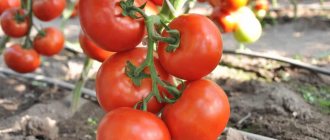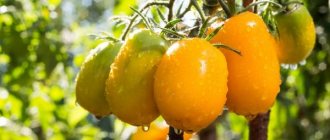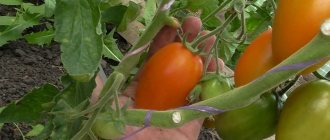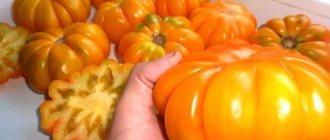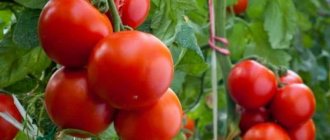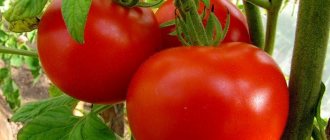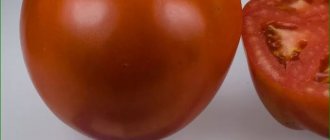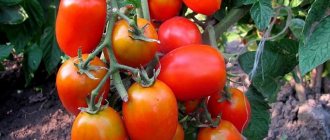The cheerful gnome is a baby tomato with low and compact bushes. Convenient for planting in beds, flowerpots and pots in the apartment.
| Height | Landing location | Ripening time | Fruit color | Fruit size | Origin | Fruit shape |
| short | Greenhouse, Open ground | Early ripening | Reds | Average | Variety | Plum-shaped or oval |
Description and characteristics of the variety
Tomato Cheerful Gnome is a determinate, low-growing variety, the shoots do not exceed 40 cm in height. They are characterized by medium foliage. Does not require pinching or shaping.
Ripening dates are early - 90-96 days from germination.
Tomato Cheerful Gnome from Myazina is a productive variety that bears fruit with an average weight of 70-90 g. The length reaches 12 cm. The skin is dense and does not crack from high temperatures. The pulp is dense, moderately juicy. The taste harmoniously combines sweetness and tomato sourness.
Tomatoes have a universal purpose. They are used for preservation whole and in slices, for making juices and ketchups for the winter. They are especially tasty fresh in slices and salads.
Pest and disease control
To prevent fungal diseases, the Cheerful Gnome tomato bushes can be treated once with fungicides in May (a few days before planting in the greenhouse):
- Bordeaux mixture;
- "Fitosporin";
- "Maksim";
- "Tattu";
- "Topaz";
- "Fundazol".
If insects are found, the plantings should be sprayed with homemade solutions or infusions (onion peels, chopped garlic, citrus zest, chili pepper, baking soda) or insecticides:
- "Aktellik";
- "Fitoverm";
- "Biotlin";
- "Aktara";
- "Karate";
- "Fufanon."
Attention! It is advisable to process the bushes late in the evening, in the absence of rain and strong wind (when grown in greenhouse conditions). After applying the chemical, the fruits can be collected no earlier than 5-10 days.
Features of cultivation and storage
Seedlings are planted in beds taking into account crop rotation. Optimal predecessors are legumes, green manure, carrots. Holes are dug at a distance of 30 cm, the distance between rows is 60 cm. 4 tomatoes are planted per 1 m2.
Add into the hole:
- 1 handful of rotted humus;
- superphosphate 10 g.
- 1 tbsp. wood ash.
The optimal time for planting is when the air temperature is stable at least 15-18 degrees. The shoots are tied to a trellis and formed into 1-2 shoots.
Ripe tomatoes are stored well for up to 1 month and are transported without damage or deformation.
What's good about this variety?
Cheerful gnome - compact tomatoes and, according to the description of summer residents, surprisingly elegant. Borders of these sturdy little bushes make a vegetable garden surprisingly attractive.
In addition to attractiveness, other advantages are noted:
- Early ripening period is 100-110 days after the appearance of the first shoots.
- Compact bushes that do not require the formation and pruning of stepsons.
- Excellent taste of fleshy fruits.
- Productivity – up to 3 kg per bush.
- Tomato does not require large areas for planting - plants can be planted at a distance of 30 cm in a row.
- Universal use of fruits - suitable for salads, canning and even drying.
Disadvantage - despite the resistance to temporary cold snaps, at lower temperatures the ripening time is much later.
Advantages and disadvantages
This variety has many advantages
The main ones include the following:
- versatility in use;
- unique product and taste qualities;
- high level of productivity: from 1 sq. m harvest about 7 kg of selected tomatoes;
- resistance to most diseases.
This type has no disadvantages.
Rules for caring for the “Jolly Dwarf”
Determinate tomatoes with a standard bush are quite easy to care for. When growing them, it is customary to follow standard rules. Considering the characteristics of the variety, its resistance to low temperatures, diseases, short ripening times and a guaranteed yield of 1.5 kg, you can safely get down to business.
- It all starts with the seeds being disinfected in a weak solution of manganese, hardened in a refrigerator, and saturated with microelements by placing them in a “growth stimulator.”
- To obtain high-quality seedlings, a balanced composition of the soil mixture is important. The substrate must be loose, breathable and moisture-absorbing. It should be free of pests and pathogens. To do this, the earth is heated at 80-90 degrees.
- Seeds are planted 50 - 55 days before planting in the ground. This approximately occurs in early April.
- Seedlings dive into separate cups with the appearance of 1-2 true leaves. Lighting and temperature modes are selected individually, depending on the condition of the plants. Water the seedlings moderately, trying to maintain soil moisture at 70 - 80%.
- Plants are planted in the ground after the end of spring frosts in May. If seeds and mature seedlings are hardened in a timely manner, then the plant can be planted in a permanent place 10 days earlier.
- Compact tomatoes grow well in thickened plantings, according to a 30 x 30 pattern. Care comes down to fertilizing, watering, timely weeding and loosening the soil.
See also
Description of the Dorodny tomato variety, growing characteristics and yieldRead
Released early ripening varieties usually cause little trouble. Caring for them is simple, but the “Jolly Gnome” brings so much joy once it appears on the dining table. It is noticeably different from traditional round tomatoes, always attracting everyone's attention.
Growing tomatoes
Characteristics of the Cheerful Gnome tomato shows that the variety does not require special care when growing. Seeds of this variety are not planted in open ground, so you will have to pay attention to the seedlings.
To get a good harvest, the seedlings must be healthy and strong, and therefore it is better to grow them yourself.
Before sowing, the seeds must be disinfected in a solution of potassium permanganate and treated with a growth stimulator. You can buy a growth stimulator or use aloe juice for this purpose.
The mixture for sowing should be loose and light; summer residents usually mix ordinary garden soil with compost and ash.
Sowing begins two months before planting seedlings in the ground, that is, around the beginning of April. The soil needs to be moistened, seeds sown in rows, sprinkled with soil on top and lightly compacted. Cover the box itself with film, and in a few days the seeds will hatch. After this, the film must be removed and the box placed in a bright place so that the seedlings do not stretch out.
In the next two weeks, the seedlings need to be hardened - maintain the temperature at about 15-16 degrees and water moderately. After hardening, the temperature is increased to 22-24 degrees, and when real leaves appear, the seedlings can be pricked.
The Cheerful Gnome tomato has compact bushes, so they can be planted every 30 cm, leaving a distance between rows of about 50-60 cm. The holes are fertilized with rotted manure, mineral fertilizers, and ash. Seedlings are planted in the ground when the threat of frost passes.
Tomatoes Gnome: the richest series of varieties
Tomatoes from the Dwarf series are the brainchild of the collective work of breeders from different countries. American and Australian amateur vegetable growers were the first to develop this variety at the beginning of our millennium. Soon breeders from Russia and other countries joined them. Work on developing varieties of this tomato variety continues.
Breeders initially set themselves the task of creating a variety of tomatoes characterized by abundant fruiting in cramped conditions, and at the same time viable. We should give credit to the enthusiasts; they accomplished these tasks.
Landing
"Gnomes" are grown through seedlings. Seed producers recommend sowing in late March - early April.
Disinfection. To increase germination and develop immunity to diseases, the seeds are pre-treated with a weak solution of potassium permanganate (for 20 minutes) or copper sulfate. After this, they are washed and placed in a growth stimulator for 6 hours. It is also necessary to disinfect the soil in which the seedlings will live for the next one and a half to two months.
Landing. Seeds are planted in boxes with drainage holes at a distance of 2-3 centimeters from each other. The planting depth should not exceed one and a half centimeters. The container is covered with transparent film (or glass) and placed in a warm, bright place. Comfortable temperature for this stage is + 25 degrees. Usually, in the first days after planting, watering is not required, since moisture is well retained in greenhouse conditions. If the top layer of soil begins to dry out, you should spray it with warm water from a spray bottle.
Picking. When the first shoots appear, the film is removed. Preparation for adult life begins: the ambient temperature is reduced to + 18 degrees, but the seedlings are still provided with a lot of light. Picking is carried out when one or two full leaves appear on the seedling.
Watering. Moderation is the main rule for growing Gnome. Water the seedlings only when the top layer of soil dries. High humidity can lead to root rot. On the other hand, lack of water will slow down the development of seedlings. For irrigation, use settled water at room temperature.
Sunbathing. Daylight for seedlings should last at least half a day. If it's gloomy outside, you'll have to use fluorescent lamps. The “gnome” usually does not reach out to windows when there is a deficiency of ultraviolet light, but with good lighting the seedlings grow faster.
Moving to the garden
Seedlings can be planted for permanent residence after 45-55 days (under film - in mid-May, in open ground - in early June). Of course, a lot depends on the climate zone and weather. If the ground is not warmed up, or even frosts occur at night, you should wait to “move” to the garden bed. The variety loves fertile, airy, loose soil with neutral acidity.
For planting in open ground or a greenhouse, it is better to choose a cloudy day or evening so that the sun's rays do not damage the greenery that has not yet matured. 4-5 young tomatoes are placed on one square meter. The distance between rows should be at least 35 cm.
